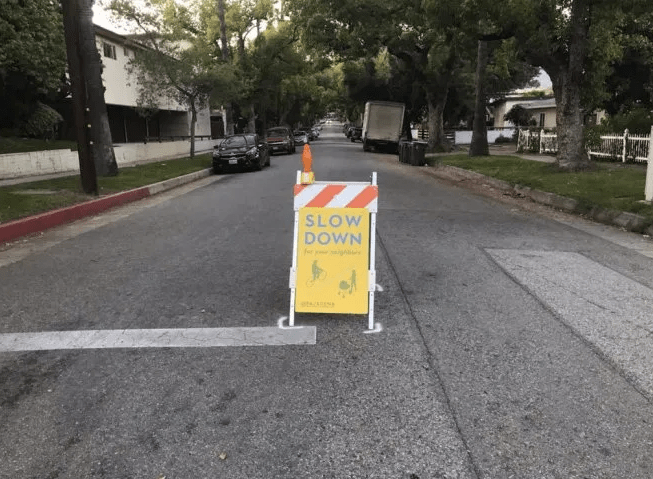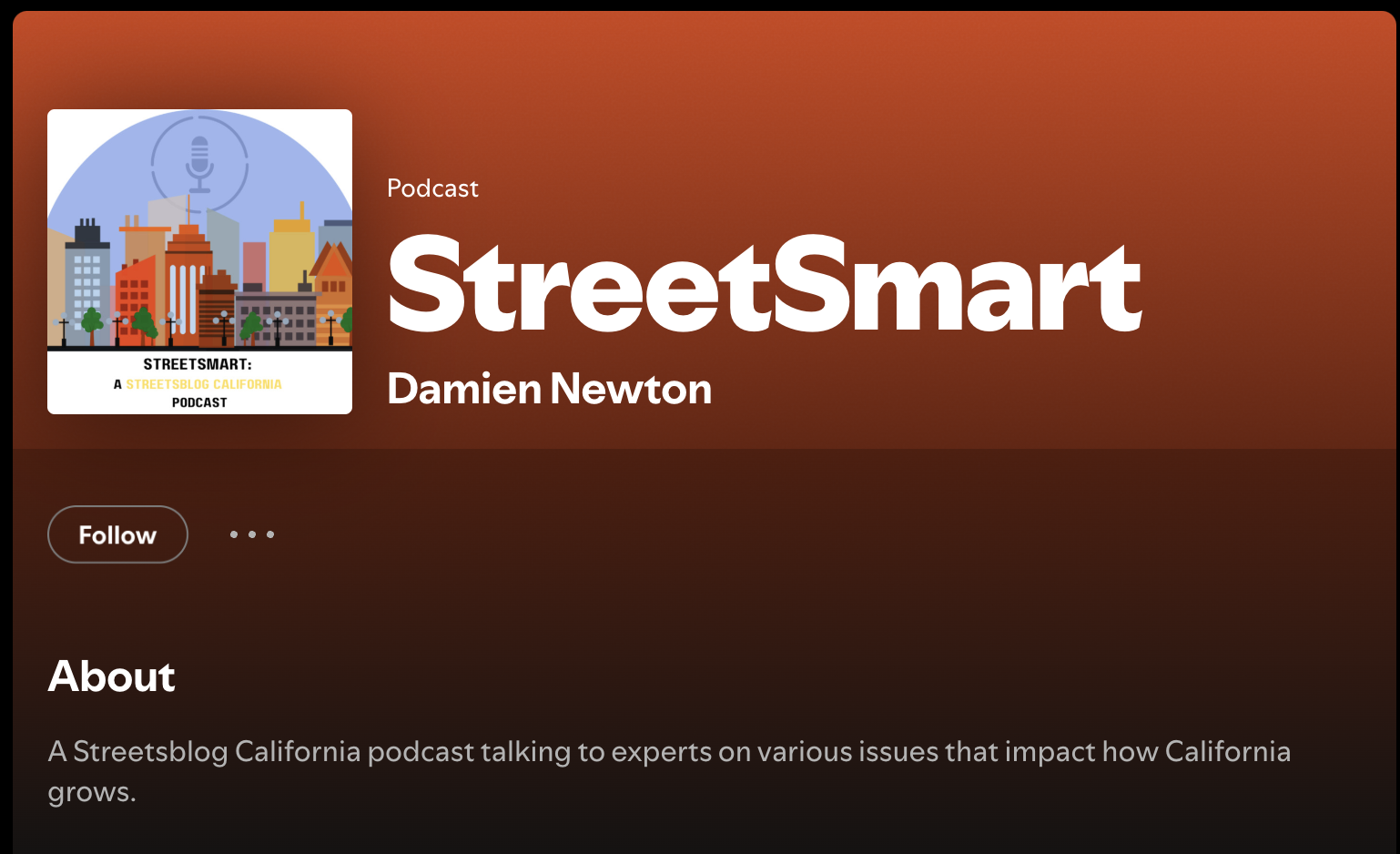Pasadena, in response to the Safer at Home Order, has rolled out a multifaceted strategy to enhance safety for folks traveling on its streets.
On April 28, Pasadena transportation staff started placing 500 signs at entrances to residential neighborhoods throughout the city reminding drivers to slow down for bicyclists and pedestrians using the road to maintain social distancing. Signs will be in place until the order is lifted and public parks and recreation centers reopen to the public.
“Roughly 500 signs will be installed throughout the city, creating a network of over 100 miles of Slow Streets, and we’ll be relying on residents’ feedback to optimize placement of these signs,” said Laura Cornejo, director of transportation.
Pasadena's action bears some similarities to cities around the world taking steps to ensure people walking and bicycling are safe under COVID-19 isolation measures. With residents sheltering at home, and many trails and recreational spaces closed, people are out walking more than usual. Sidewalks have become inadequate for needed distancing, sometimes forcing people to walk in the streets. At the same time, with fewer cars on the road some drivers are speeding dangerously.
Cities have taken varied approaches to calming traffic under COVID-19. Many city programs, including Oakland Slow Streets and Seattle Stay Healthy Streets, resemble bike boulevards - relatively small calm streets that pedestrians, cyclists, and drivers can all share. Oakland and Seattle temporarily calmed these streets without closing them to cars, primarily by blocking selected entrances to cut-through car traffic. Some cities, including New York and Washington DC, have used traffic cones to reallocate road space (generally one traffic lane) away from cars and to people walking and bicycling. Some cities, including New York, San Francisco, Philadephia, Minneapolis, and Pasadena with its Rose Bowl Loop, have fully closed some streets to car traffic - generally in or along park settings.
Pasadena City staff decided to keep local streets open and accessible to traffic because they felt there remained a need for essential workers to get to and from work, maintain access for deliveries, and residents to make essential trips. “It is not our intent to close streets to vehicular traffic,” said Joaquin Siques, a City traffic engineer. “The Pasadena Transportation Department believes it is important to balance the access needs of residents with the desire to slow motorist traffic on local streets in residential neighborhoods.”
The Los Angeles County Department of Public Health reported today that Pasadena has 593 coronavirus cases, 66 which have proven fatal.
Sign locations were identified citywide at intersections where local residential streets connect to larger collectors and arterials streets. The Pasadena Transportation Department is currently evaluating available data to compare driver speeds before and during the Safer at Home Order - for both collector and arterial streets.
Enjoyed a ride with my daughter today in beautiful Pasadena and saw the great new @PasadenaDOT signs. TY!
— Jason Neville (@nevitate) May 6, 2020
But judging by the cars speeding past us all afternoon, they’re not working.
Can they be moved from the gutter to the center lines?#walklocalbikesolo @PasadenaCSC @Day1DO pic.twitter.com/kqE8WcR5vm
Pasadena resident and advocate Misch Anderson said she toured the city recently to see how the signs were being rolled out and saw that streets with signs placed in the middle of the road had slower traffic. In other roads though, signs were placed next to the curb, and in the gutters in some cases. “I would far prefer as a driver, pedestrian and cyclist, to have the signs be right where I can see them, ” she said.
Pasadena also launched a Walk Local, Bike Solo cross-channel social media campaign. This campaign has been promoting self-guided neighborhood tours, encouraging residents to support local restaurants and to share COVID-19 health and safety reminders.
One component of Walk Local, Bike Solo includes a free drop-off bike repair service for those experiencing financial hardship due to COVID-19. Once an appointment is made on the online application, participants will receive the address of the drop-off location.
Additionally, traffic signal timing along 10 major corridors have been modified to operate in “nighttime mode,” also known as “free mode” operation, all day in an effort to reduce motorist speed. When intersections run in nighttime/free operation, traffic is served on a first-come, first-served principle. Select signals will remain red until traffic—whether it be a motorist, pedestrian or bicyclist—approaches the intersection. Once traffic approaches, the signal changes within seconds.
Modifications to the signal timing have been implemented along the following corridors:
- Washington Boulevard – Lincoln Avenue to Allen Avenue
- Orange Grove Boulevard – Fair Oaks Avenue to Sierra Madre Boulevard
- Walnut Street – Raymond Avenue to Foothill Boulevard
- Colorado Boulevard – Allen Avenue to Madre Street
- Del Mar Boulevard – Los Robles Avenue to San Gabriel Avenue
- Sierra Madre Boulevard – Orange Grove Boulevard to Hastings Ranch Drive
- Hill Avenue – Washington Boulevard to California Boulevard
- Lake Avenue – Washington Boulevard to Villa Street
- Fair Oaks Avenue – Montana Street to Villa Street
- Lincoln Avenue – Montana Street to Washington Boulevard
What the city is not doing is automating pedestrian pushbuttons. Under COVID-19, some cities are eliminating these "beg buttons" to increase safety for people walking, allowing them to touch fewer potentially-virus-laden surfaces. Pasadena was initially considering automating crosswalks citywide during the safer at home order, but decided against it. Siques said "unintended safety consequences" and the level of effort to implement were reasons why the City chose to keep pushbuttons as is. (To learn more about the pushbutton issue, check out SGV Connect's most recent podcast episode with Misch Anderson).
“This three-tiered campaign is a reminder that roads are multi-modal and are meant to be safely shared by all,” said Cornejo.
Streetsblog L.A.'s coverage of the San Gabriel Valley is supported by Foothill Transit, offering car-free travel throughout the San Gabriel Valley with connections to the new Gold Line Stations across the Foothills and Commuter Express lines traveling into the heart of downtown L.A. To plan your trip, visit Foothill Transit. “Foothill Transit. Going Good Places.”
Sign-up for our SGV Connect Newsletter, coming to your inbox every Friday starting on May 22:
#mc_embed_signup{background:#fff; clear:left; font:14px Helvetica,Arial,sans-serif; }
/* Add your own Mailchimp form style overrides in your site stylesheet or in this style block.
We recommend moving this block and the preceding CSS link to the HEAD of your HTML file. */
Subscribe
//s3.amazonaws.com/downloads.mailchimp.com/js/mc-validate.js(function($) {window.fnames = new Array(); window.ftypes = new Array();fnames[0]='EMAIL';ftypes[0]='email';fnames[1]='FNAME';ftypes[1]='text';fnames[2]='LNAME';ftypes[2]='text';fnames[3]='ADDRESS';ftypes[3]='address';fnames[4]='PHONE';ftypes[4]='phone';}(jQuery));var $mcj = jQuery.noConflict(true);






